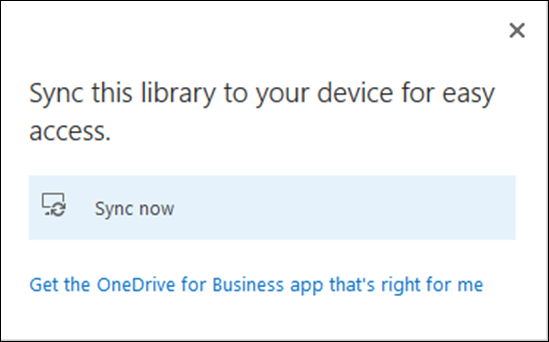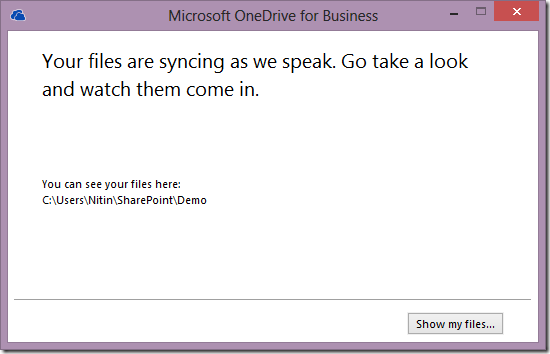This is a concise guide to using OneDrive for Business (ODB). Using it on browser and synching it is easy. What is NOT easy is to actually use it. It often so happens that we install it and never use it.
Here are the best practices for using it in such a way that it provides benefits without becoming a hindrance.

If you are not familiar with OneDrive for Business,
please read my earlier article What exactly is OneDrive
Contents
Recap
OneDrive for Business is a SharePoint document library in your personal site on Office 365. You get 25 GB of space. To use it, you must have the login id and password to your Office 365 site. If you are not sure about whether you have the subscription, clarify with your IT team.
Using OneDrive for Business
It is a place to store files. It can be used in three different ways.
- Using any browser
- From Office tools
- OneDrive for Business Apps
- Using regular File Explorer on Windows
Using Browser
Initially you will need to login to the Office 365 portal. On the top bar you will see OneDrive. Click to view the OneDrive contents.

By default there will be just one folder called Shared with Everyone. That folder is also empty.
Now consider this as your MY DOCUMENTS folder. DO NOT store files immediately in this place. Like we do on a local PC, we must create a sensible and logical folder structure here as well. So resist the urge of randomly uploading files here.
To upload files, you can choose upload button or even drag drop files from File Explorer or other places.

Look at the gray bar at the top. It shows a very important piece of information – which will make more comfortable storing files on OneDrive.
It says Documents are private until shared. In short, when you store a document here, nobody can see it unless you decide to show (share) it with others.
If you want everyone to see the file, add it to the Shared for everyone folder. Everyone means everyone in your organization.
You can sort, filter, group files here.
Files which are visible only to you (which is the default) are shown with a lock symbol. Files which are shared with others show the people icon.

From Office tools
This is the best way. Easy and powerful. Works best with Office 2013.
Choose File – Accounts and Add a Service and choose Office 365 SharePoint

Once you login, this place will appear in the File – Open and File – Save menus automatically. This makes it extremely easy to create documents and store them directly on ODB. No manual work required to remember long URLs for ODB.

Using Apps
OneDrive Apps are available on Windows, Android and iOs.
In addition, the Android you can open ODB files from the Office App.
Using regular Windows Explorer
Go to the browser version first and click on the Sync Button. This is only to be done for the first time. Do this when there are few files inside.

Choose Sync Now in the next window.

It will then show you where the files will be stored on the local PC or device.
Click Sync Now

The synchronization will start in the background. You don’t have to wait for it. Click the Show My Files button

Windows File Explorer will open and show you the local folder which will now be kept in Sync with OneDrive for Business.
For all practical purposes, consider this as your NEW MY DOCUMENTS.
You will notice that this folder also appears in the Favorite Shortcuts in Windows Explorer as well as File Open / Save dialogs. This way, it is always one click away.

So far so good. The technology part is done. Now let us understand the psychology
Have courage: Create and store files directly to ODB
The core concept is that all new documents should be created in ODB and NOT in the local My Documents folder. If you store in My Documents and then COPY to ODB, it is an absolutely inefficient as well as confusing approach.
Remember: Nobody else can see your files until you decide to share.
Even here we have two choices.
- Create file in Office tools – File – Save As – Choose OneDrive for Business – use when online
- Save into the local Synchronized folder – use when offline
Technically, both these mean the same thing. So to simplify your life – just store it in the local sync folder for OneDrive for Business by default. It will be uploaded to the server automatically. A small green mark shows that the file is in Sync.

Red cross means there is an issue with the file and it is not yet gone to the server. The blue round arrow indicates that the synchronization is still happening.
Remember to sync to all devices
If you use a laptop, desktop, tablet and iPad, make sure that the OneDrive for Business is synchronized to all these devices.
You will have to take the trouble to establish the Sync for the first time on each device. But once this is done, you will get peace of mind.
The only downside of this is that this whole thing consumes lot of bandwidth if files are very large. If you create one large file, it will synchronize it across all devices – so the bandwidth will be consumed multiple times.
Moving existing files to ODB
Whatever we have discovered so far applies to newly created files. What about the older ones? We have to remember to store them in ODB now.
So here is what you need to do. Whenever you open a file – think – is it outside ODB? then immediately save it to ODB and then edit it. Ideally you should move the original files to ODB, but that can lead to two types of problems.
- Linked files depend upon the file path. If you randomly move files, it will break the link
- Although 25 GB is lot of space, you may have old files which easily exceed this space.
For both these reasons, you should try to move files which are in active usage. You will be surprised to see that we actually use only a small subset of files on a daily basis.
I suggest you use a tool called TreeSize to assess which are the recently used files (last 1 year may be) and move those – along with the folder structure to OneDrive.
Remaining files can be moved on demand.
Benefits of this approach
Whichever method you use for using OneDrive for Business, there are lots of benefits you get. These include:
- You get full control over visibility of the file to others
- You can decide who can view the file
- You can decide who can edit the file
- You can be automatically notified if anyone else changes the file
- Whenever file is changed, previous version is automatically saved
- Multiple persons can now edit the file simultaneously
- You and others can view and edit the file on browser for quick editing
- Audit trail of who accessed the file when can be tracked
- You can check out the file for exclusive editing so that others cannot edit it
And many more…
In fact all these are the benefits of SharePoint. We will explore these benefits in detail, in future articles.



20 Responses
Note – when you add photos to a document library, the thumbnails/preview feature doesn’t work. When you add a picture library (which does support thumbnails/previews) to your OneDrive site, you can’t sync it to your PC/Laptop/RT/IOS device. Then once the pictures are in the picture library, there is no easy way to move them to subfolders or back and forth to a document library.
Very good article! We will be linking to this particularly great content on our website.
Keep up the great writing.
Thank you for the feedback. Do let me know if you have any specific needs or topics in mind.. I will cover then in my upcoming articles.
Do have a look at the track changes risk article and document inspector (metadata cleanup) articles. All lawyers need these features.
Hello, the whole thing is going well here and ofcourse every one is sharing data, that’s in fact good,
keep up writing.
I have to thank you for the effkrts you’ve put in penning this blog.
I really hope to view the same high-grade content from you in the future as well.
In truth, your creative writing abilities has motivated me to get mmy
very own site now 😉
my %anchor% charge has been a little bit more than one pound per week. it doesnt sound like much nonetheless it provides up
Can you explain how a coworker is supposed to find a document that I drag into the “Shared with Everyone” folder. Can it be done through File Explorer
On OneDrive – Browser – or app, Files Shared with Me.
I am searching for solution to set notification for folder in a one drive business. I mean, I want to create a Folder named “board”. After that I will share it with two people. They can only view my files. When I create a new file in library, I want to send a notification to those two people. It is easy to setup in Share Point document library but the storage is limited in SharePoint Online. But on one drive, storage limit is 1 TB per user. How can I setup this scenerio?
Hi
When you add a file or modify it you don’t need to send the notification to others manually. SharePoint will do it for them.
They will have to go to the document library and create alerts – Library Tab – Alert Me.
They can decide the trigger event (Add, Change, Delete) and the frequency (immediate, daily, weekly) for the notification.
Hi!
As today, there is no auditing in office 365 to know who acessed/viewed a file. You have that option only in Sharepoint server.
Hi Nuno
It is possible. Site Settings – Site Collection Audit Settings. Enable Auditing. To view the auditing add the /reporting.aspx?Category=Auditing to the base URL.
https:///_layouts/15/Reporting.aspx?Category=Auditing
All reports are available exactly like regular SharePoint.
Hi Nitin,
Nope 🙂
I was hopping you were right, but unfortunately my office 365 say’s:
Specify events to audit For Documents and items:
* Items edition;
* Enter or remove items;
* Move or copy items from another location inside the site;
* Eliminate or restaore items.
Specify events to audit For Lists or Librarys and Sites:
* Edit types of subjects and columns;
* Search inside the site;
* User and permitions edition
I will write an article on it with screenshots tomorrow. Which edition of Office 365 are you using?
Hi! I have the Small Business Premium.
In Portuguese
I have shared some files with 2 external users of my domain, and they tell me that they are aware of whom has access. How to avoid this ?
I want to share this folder with my clients, but it is vital that they are not aware of each other.
Are these users from same domain? or external users with Sign In compulsory?
Hi!
Different domains and compulsory sign in.
Internal or External sharing makes the users a CONTRIBUTOR (assuming you have allowed editing). Contributor cannot see who else the library or document is shared with.